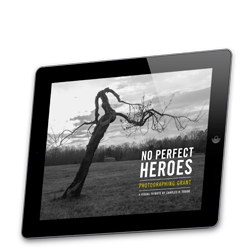
No Perfect Heroes (2016) 11.99$
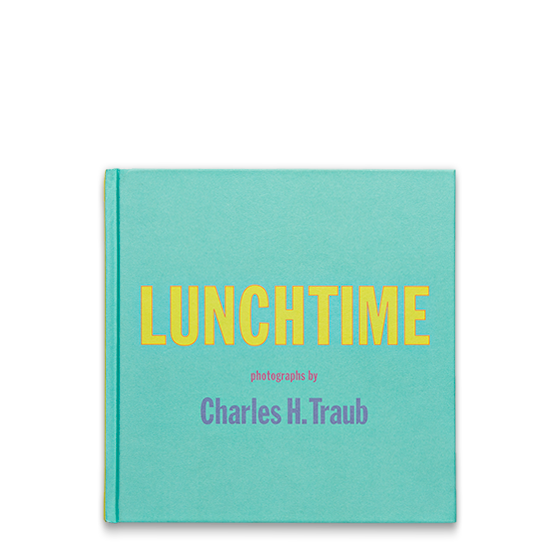
Lunchtime (2015)45.00$
Between 1977 and 1980, Charles H. Traub ventured onto the streets of Chicago, New York and various European cities to take photographs of their inhabitants–male and female, young and old-at lunchtime. Colorful and direct, animated and intimate, the portraits are shot close to the subjects, composed seemingly off-the-cuff, focusing on just their heads and shoulders. Each subject reveals something of himself or herself to the camera...

Vision Anew (2015)
The ubiquity of digital images has profoundly changed the responsibilities and capabilities of anyone and everyone who uses them. Thanks to a range of innovations, from the convergence of moving and still image in the latest DSLR cameras to the growing potential of interactive and online photographic work, the lens and screen have emerged as central tools for many artists. Vision Anew brings together a diverse selection of texts by practitioners, critics, and scholars to explore the evolving nature of the lens-based arts | Edited by: Adam Bell & Chalres Traub
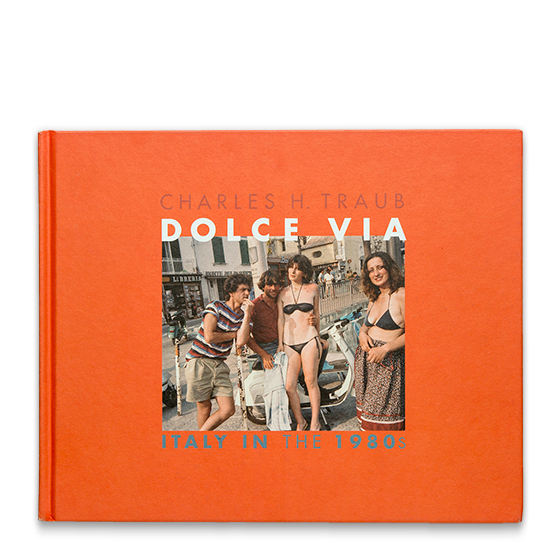
Dolce Via (2014)
Damiani is pleased to announce the release of Dolce Via: Italy in the 1980s (Damiani, March 2013), featuring photographs by Charles H. Traub, with a foreword by Max Kozloff and a dialogue by Luigi Ballerini. Throughout the 1980s, Traub was a frequent visitor to Italy, and the resulting book is full of striking color photographs, shown together for the first time since the mid-1980s.

Object of My Creation (2011)
What Traub had captured with his camera lens took on new life in the darkroom: it became an object of his creation. "When these pictures were made, I was still in my salad days. A “youth!” An admirer! A wannabe! I was looking for me. Hip lifestyles, pseudo spiritualism and pot euphoria teased maturity. Nature was the supposed alternative to the material pursuits and the junkyard of suburbia, but from my service experience I knew all too well the vicissitudes of its wrath. The darkroom was safer than the tent."

Charles H. Traub, Monograph (2006)
Photography gave Traub the freedom to get close, really close to people which, given the narcissism of the time, was an opportunity they mostly welcomed. Making pictures was a way for him to punch up and elevate his every day experience, and to capture the humor, friction, and sexiness of a hyperactive and visual world characterized by the sheen of polyester, the buzz of conflicting patterns, conspicuous displays of head and body hair, and unexpected and beautiful interactions of shadows and light.
Introduction by: Marvin Heiferman

The Education of a Photographer (2006)
The Education of a Photographer intends to bring inspiration and insight to everyone who engages or is interested in lens-based media. It offers 51 essays and interviews by a talented group of industry renowned photographers, teachers and thinkers. From early twentieth-century masters to postmoderns on to today’s incisive visionaries, this thought provocking book navigates the reader through the varied landscape of photography, eloquently expressing what it means to be a photographer today. Edited by: Charles Traub, Steve Heller and Adam Bell
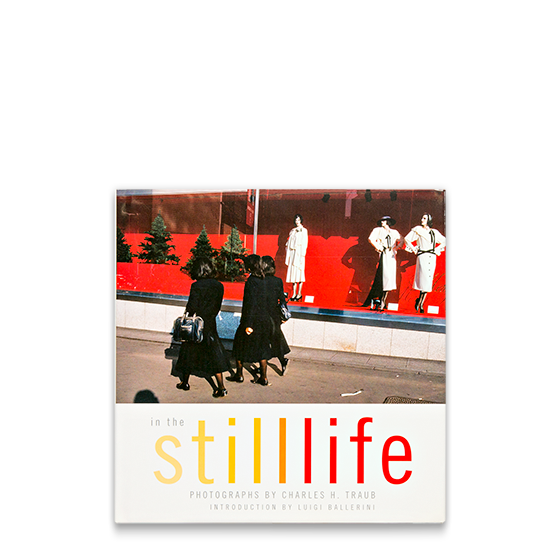
In The Still Life, Monograph (2004)
The pictures in this book were made from the mid 1980’s to the present. All of these images are now transformed by time and new associations and have little connection to any reason for which they might have originally been made. They are ascribed new roles via their ability to stimulate the viewer’s own memories or fantasies of similar passages through the social landscape. I hope that the strength of these images is that they assume different guises for different people yet remain relics (still lives) of the period and places in which they were made...[more]
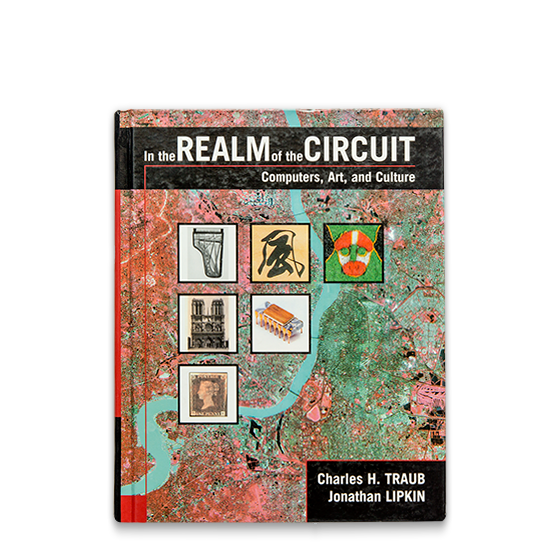
In the Realm of Circuit: Computers, Art, and Culture, a textbook. (2003)
Broad in scope, this book provides a clear introduction to both the aesthetics and historical precedents of the multi-faceted dialog of which electronic multimedia is the latest incarnation. It tells the story of how technology has always been integrally connected to human expression and gives users the tools to connect their technological practice to their cultural heritage. For more information: www.intherealmofthecircuit.com | by Charles H. Traub and Jonathan Lipkin

Here is New York: A Democracy of Photographs, (2002)
Here is New York was founded in response to the events of September 11, 2001 and to the flood of images that resulted from it. The idea was simple: to present images of the event by as many different people and from as many different perspectives as possible. In the days following September 11, the organizers asked for pictures from photographers of every description, not only top photojournalists and other professionals, but also from rescue workers, firemen, police officers, school children and amateurs of every kind...[more] | Co-Edited by Charles Traub

Italy Observed In Photography & Literature, co-edited by Charles H. Traub (1991)
Luigi Ballerini and Charles Traub take us out of the confines of Venice and spread all of Italy at our feet. They also take us from the world of fantasy to the world of perception. The authors present famous travelers’ observations of the country and its people. Nathaniel Hawthorne celebrates the ruins of the mighty Roman Empire, while Henry Wadsworth Longfellow waxes poetic about the Eternal City itself. the beauty of this book lies in its photographic interpretation of the country and its people...[more] | By Luigi Ballerini and Charles Traub

An Angler’s Album: Fishing in Photography & Literature, edited by Charles H. Traub (1990)
Writer and photographer are both engaged in contriving–angling–to make an image probable through artifice. Trying to take advantage of the synergism that results from combining writing, photography and fishing, Traub has made artful juxtapositions. The pairings of the quotations and photographs are not necessarily illustrative of one another but are intended to create an unexpected view of angling and its aspects. As a pictorial of modern fishing and photography, the book has scholarly, historical and sociological interest...[more]

Figure Della Danza (1983)
missing text - this is really sad, and I hope we will get it solved as soon as possible. In the meanwhile, thank you for making sure that everything is working on this website. Best - an anonymous developer.
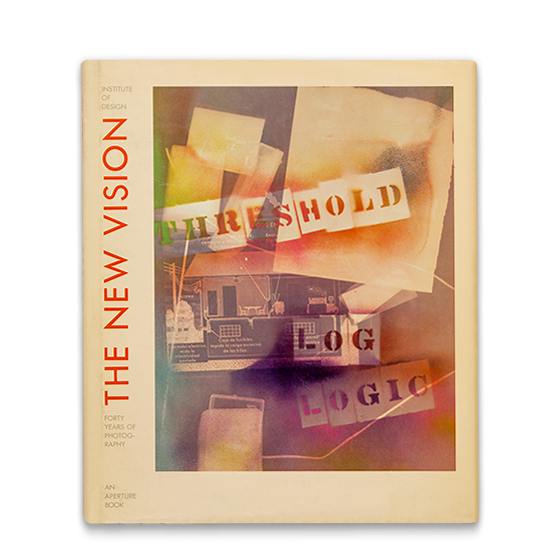
The New Vision (1982)
The New Vision: Forty Years of Photography at the Institute of Design In interviews and photographs, students and teachers of Chicago’s Institute of Design recall the innovative spirit and socially relevant education that have made the school a vital force in photography for over forty years | Edited by Charles Traub, Introduction by John Grimes. New York: Aperture, 1982
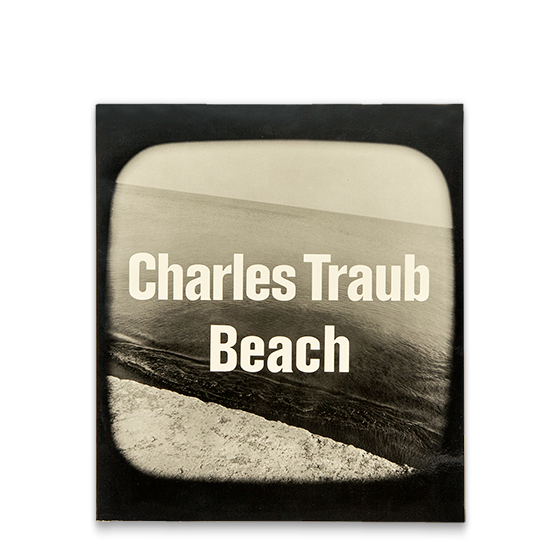
Charles Traub: Beach (1978)
“Vivid and compelling photos which are painful and provocative. They are poignant in their self- conscious stylization, and Traub is not without a sense of wit.” –Peter Bunnel, Director Princeton University Art Museum “The habit of modern life is the subject of these fantastic photographs. We find them in the arena of the imagination that sees little difference between document and fantasy. It is a circus where uniform becomes costume, disfigurement becomes attraction.” –David Travis, Curator of Photography Art Institute of Chicago

No Perfect Heroes (2016) 11.99$

Lunchtime (2015)45.00$
Between 1977 and 1980, Charles H. Traub ventured onto the streets of Chicago, New York and various European cities to take photographs of their inhabitants–male and female, young and old-at lunchtime. Colorful and direct, animated and intimate, the portraits are shot close to the subjects, composed seemingly off-the-cuff, focusing on just their heads and shoulders. Each subject reveals something of himself or herself to the camera...[more]

Vision Anew (2015)
The ubiquity of digital images has profoundly changed the responsibilities and capabilities of anyone and everyone who uses them. Thanks to a range of innovations, from the convergence of moving and still image in the latest DSLR cameras to the growing potential of interactive and online photographic work, the lens and screen have emerged as central tools for many artists. Vision Anew brings together a diverse selection of texts by practitioners, critics, and scholars to explore the evolving nature of the lens-based arts | Edited by: Adam Bell & Chalres Traub

Dolce Via (2014)
Damiani is pleased to announce the release of Dolce Via: Italy in the 1980s (Damiani, March 2013), featuring photographs by Charles H. Traub, with a foreword by Max Kozloff and a dialogue by Luigi Ballerini. Throughout the 1980s, Traub was a frequent visitor to Italy, and the resulting book is full of striking color photographs, shown together for the first time since the mid-1980s.

Object of My Creation (2011)
What Traub had captured with his camera lens took on new life in the darkroom: it became an object of his creation. "When these pictures were made, I was still in my salad days. A “youth!” An admirer! A wannabe! I was looking for me. Hip lifestyles, pseudo spiritualism and pot euphoria teased maturity. Nature was the supposed alternative to the material pursuits and the junkyard of suburbia, but from my service experience I knew all too well the vicissitudes of its wrath. The darkroom was safer than the tent."

Charles H. Traub, Monograph (2006)
Photography gave Traub the freedom to get close, really close to people which, given the narcissism of the time, was an opportunity they mostly welcomed. Making pictures was a way for him to punch up and elevate his every day experience, and to capture the humor, friction, and sexiness of a hyperactive and visual world characterized by the sheen of polyester, the buzz of conflicting patterns, conspicuous displays of head and body hair, and unexpected and beautiful interactions of shadows and light.
Introduction by: Marvin Heiferman

The Education of a Photographer (2006)
The Education of a Photographer intends to bring inspiration and insight to everyone who engages or is interested in lens-based media. It offers 51 essays and interviews by a talented group of industry renowned photographers, teachers and thinkers. From early twentieth-century masters to postmoderns on to today’s incisive visionaries, this thought provocking book navigates the reader through the varied landscape of photography, eloquently expressing what it means to be a photographer today. Edited by: Charles Traub, Steve Heller and Adam Bell

In The Still Life, Monograph (2004)
The pictures in this book were made from the mid 1980’s to the present. All of these images are now transformed by time and new associations and have little connection to any reason for which they might have originally been made. They are ascribed new roles via their ability to stimulate the viewer’s own memories or fantasies of similar passages through the social landscape. I hope that the strength of these images is that they assume different guises for different people yet remain relics (still lives) of the period and places in which they were made...[more]

In the Realm of Circuit: Computers, Art, and Culture, a textbook. (2003)
Broad in scope, this book provides a clear introduction to both the aesthetics and historical precedents of the multi-faceted dialog of which electronic multimedia is the latest incarnation. It tells the story of how technology has always been integrally connected to human expression and gives users the tools to connect their technological practice to their cultural heritage. For more information: www.intherealmofthecircuit.com | by Charles H. Traub and Jonathan Lipkin

Here is New York: A Democracy of Photographs, (2002)
Here is New York was founded in response to the events of September 11, 2001 and to the flood of images that resulted from it. The idea was simple: to present images of the event by as many different people and from as many different perspectives as possible. In the days following September 11, the organizers asked for pictures from photographers of every description, not only top photojournalists and other professionals, but also from rescue workers, firemen, police officers, school children and amateurs of every kind...[more] | Co-Edited by Charles Traub

Italy Observed In Photography & Literature, co-edited by Charles H. Traub (1991)
Luigi Ballerini and Charles Traub take us out of the confines of Venice and spread all of Italy at our feet. They also take us from the world of fantasy to the world of perception. The authors present famous travelers’ observations of the country and its people. Nathaniel Hawthorne celebrates the ruins of the mighty Roman Empire, while Henry Wadsworth Longfellow waxes poetic about the Eternal City itself. the beauty of this book lies in its photographic interpretation of the country and its people...[more] | By Luigi Ballerini and Charles Traub

An Angler’s Album: Fishing in Photography & Literature, edited by Charles H. Traub (1990)
Writer and photographer are both engaged in contriving–angling–to make an image probable through artifice. Trying to take advantage of the synergism that results from combining writing, photography and fishing, Traub has made artful juxtapositions. The pairings of the quotations and photographs are not necessarily illustrative of one another but are intended to create an unexpected view of angling and its aspects. As a pictorial of modern fishing and photography, the book has scholarly, historical and sociological interest...[more]

Figure Della Danza (1983)
missing text - this is really sad, and I hope we will get it solved as soon as possible. In the meanwhile, thank you for making sure that everything is working on this website. Best - an anonymous developer.

The New Vision (1982)
The New Vision: Forty Years of Photography at the Institute of Design In interviews and photographs, students and teachers of Chicago’s Institute of Design recall the innovative spirit and socially relevant education that have made the school a vital force in photography for over forty years | Edited by Charles Traub, Introduction by John Grimes. New York: Aperture, 1982

Charles Traub: Beach (1978)
“Vivid and compelling photos which are painful and provocative. They are poignant in their self- conscious stylization, and Traub is not without a sense of wit.” –Peter Bunnel, Director Princeton University Art Museum “The habit of modern life is the subject of these fantastic photographs. We find them in the arena of the imagination that sees little difference between document and fantasy. It is a circus where uniform becomes costume, disfigurement becomes attraction.” –David Travis, Curator of Photography Art Institute of Chicago